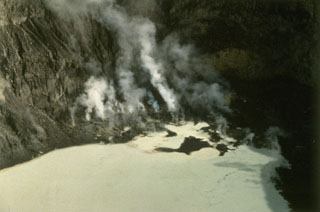Report on Mahawu (Indonesia) — April 1987
Scientific Event Alert Network Bulletin, vol. 12, no. 4 (April 1987)
Managing Editor: Lindsay McClelland.
Mahawu (Indonesia) Tectonic earthquakes, plume, elevated lake temperature
Please cite this report as:
Global Volcanism Program, 1987. Report on Mahawu (Indonesia) (McClelland, L., ed.). Scientific Event Alert Network Bulletin, 12:4. Smithsonian Institution. https://doi.org/10.5479/si.GVP.SEAN198704-266110
Mahawu
Indonesia
1.352°N, 124.865°E; summit elev. 1299 m
All times are local (unless otherwise noted)
Beginning on 17 April, a white plume was observed ~100 m above Mahawu crater. The plume persisted into early May. Between 1 and 22 April, tectonic earthquakes occurred at a rate of 1/day, with no shallow volcanic earthquakes. During the last week of April, tectonic earthquakes occurred at a rate of ~9/day and shallow volcanic events at ~5/day.
Mahawu contains a crater lake with a volume of ~40,000 m3 of greenish-yellow water. On 21 April the temperature of the lake water was 45°C, compared to a normal 20°C measured in September 1986. A strong odor of H2S was also noted by the VSI observer during his 21 April visit. VSI recommended that a circular area extending ~3.5 km from the crater be temporarily closed to public access. In January 1978, the temperature of the lake water reached 70°C without an eruption [but see 12:7 & 8].
Geological Summary. The elongated Mahawu volcano immediately east of Lokon-Empung volcano is the northernmost of a series of young volcanoes along a SSW-NNE line near the margin of the Quaternary Tondano caldera. Mahawu is capped by a 180-m-wide, 140-m-deep crater that sometimes contains a small crater lake, and has two pyroclastic cones on its N flank. Historical activity has been restricted to occasional small explosive eruptions recorded since 1789. In 1994 fumaroles, mudpots, and small geysers were observed along the shores of a greenish-colored crater lake.
Information Contacts: T. Casadevall, USGS & VSI.

